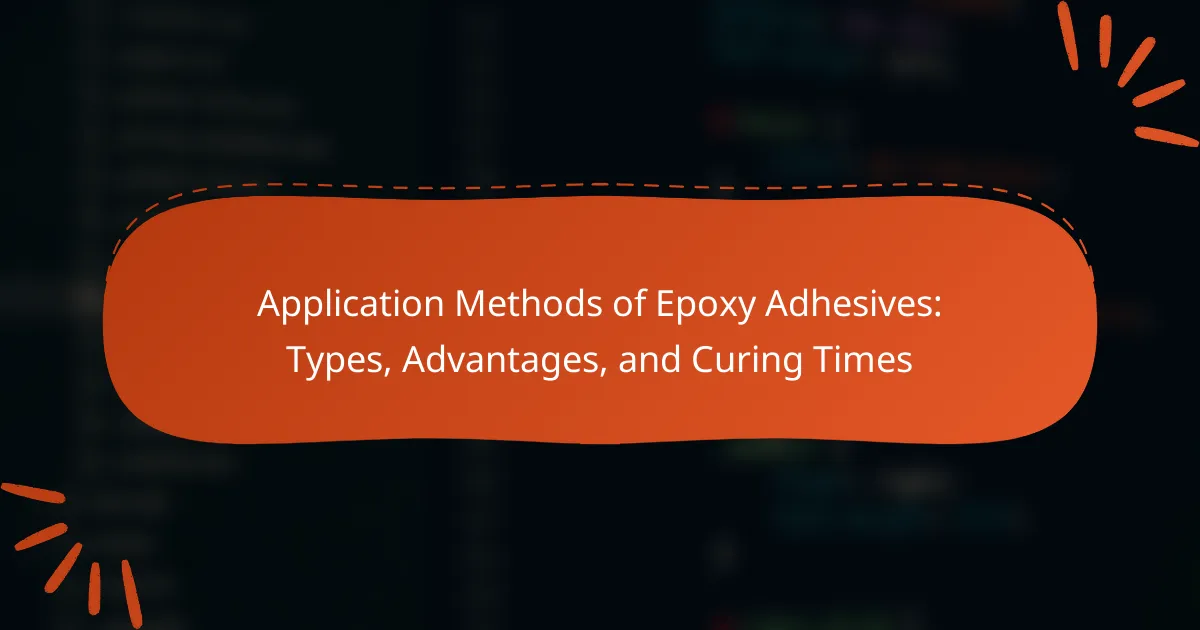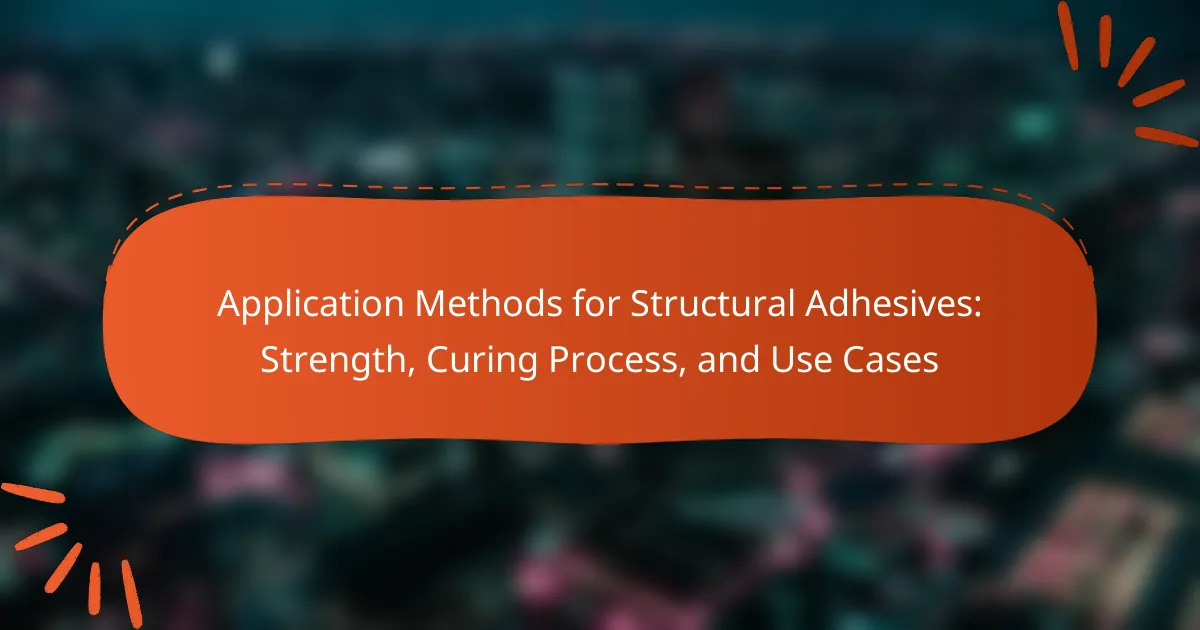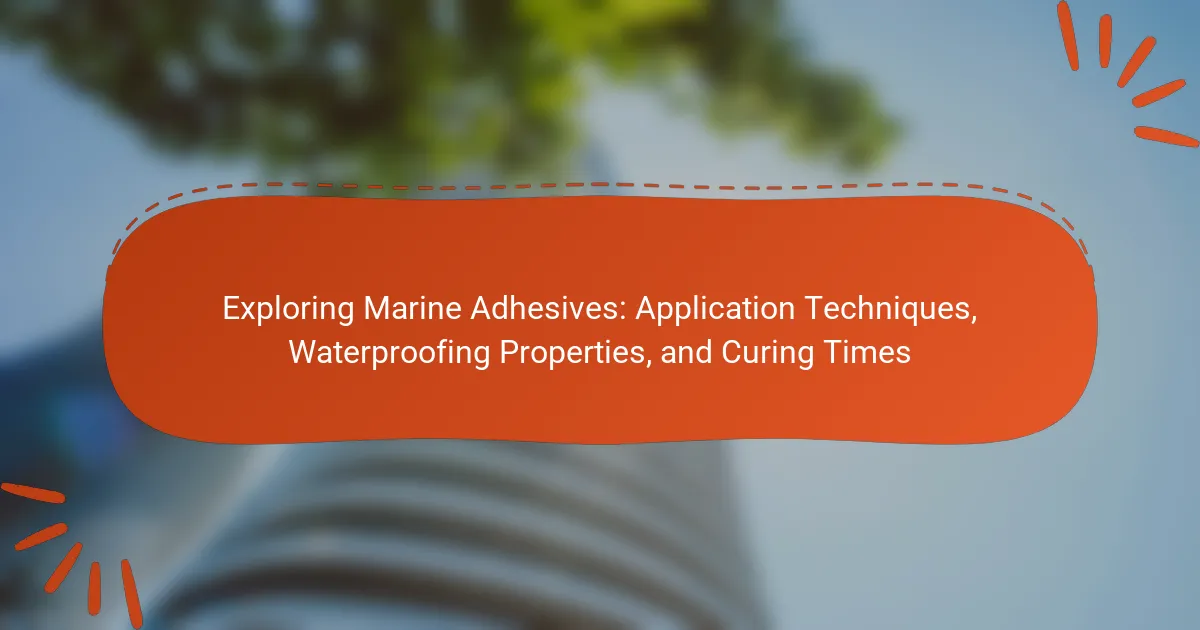Epoxy adhesives are robust bonding agents composed of epoxy resin and hardener, widely utilized across various industries for their exceptional adhesion properties. This article outlines the application methods of epoxy adhesives, highlighting their ability to bond metals, plastics, glass, and wood effectively. Key advantages include strong tensile strength, moisture and chemical resistance, and excellent gap-filling capabilities, making them suitable for demanding environments. Curing times for these adhesives vary, typically ranging from 5 minutes to 24 hours, influenced by factors such as temperature and humidity. Understanding these aspects is crucial for optimizing their performance in construction and manufacturing applications.
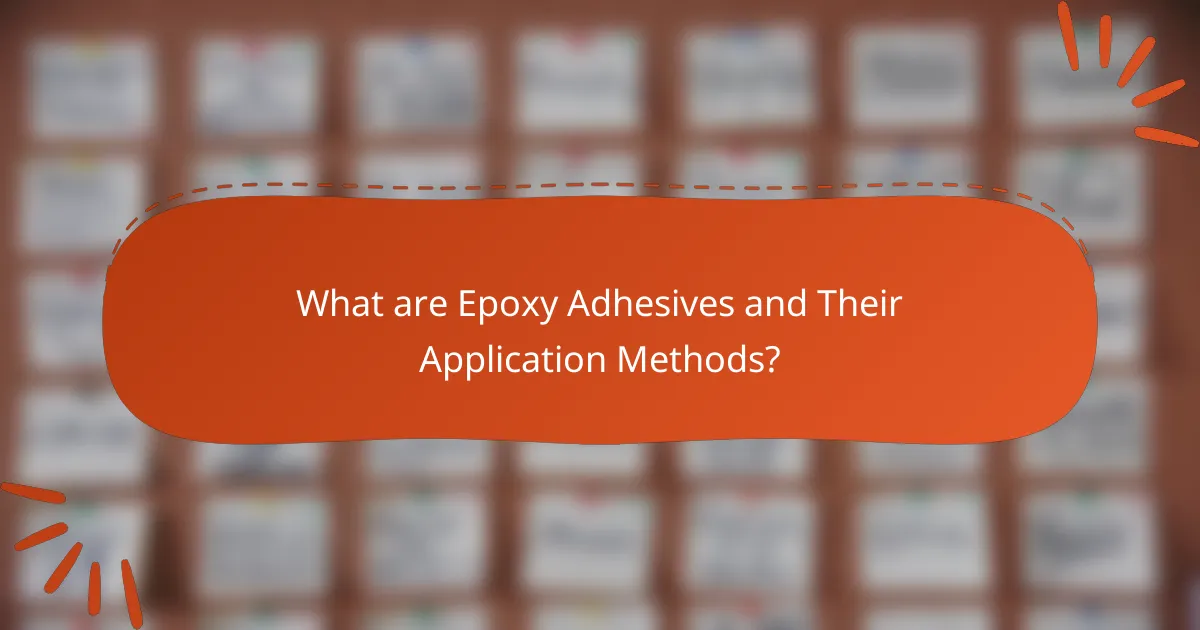
What are Epoxy Adhesives and Their Application Methods?
Epoxy adhesives are strong, durable bonding agents made from a combination of epoxy resin and hardener. They are widely used in various industries due to their excellent adhesion to different substrates. Epoxy adhesives can bond metals, plastics, glass, and wood effectively. Their application methods include mixing the resin and hardener before use, applying the mixture to the surfaces, and allowing it to cure. Curing can occur at room temperature or be accelerated with heat. The typical curing time ranges from a few hours to several days, depending on the formulation. These adhesives are known for their resistance to chemicals and moisture, making them suitable for demanding applications.
How do Epoxy Adhesives work in bonding materials?
Epoxy adhesives work by creating a strong bond through a chemical reaction between two components. These components are typically a resin and a hardener. When mixed together, they undergo curing, a process that transforms the liquid mixture into a solid material. This solid state provides excellent adhesion to various substrates, including metals, plastics, and ceramics.
The bonding occurs at the molecular level, where the epoxy forms cross-links between the resin and the surfaces being bonded. This results in a durable and resistant bond that can withstand stress, temperature changes, and environmental factors. The effectiveness of epoxy adhesives in bonding is supported by their high tensile strength, often exceeding 3,000 psi, and their ability to fill gaps between surfaces.
Furthermore, epoxy adhesives are resistant to chemicals and moisture, enhancing their performance in diverse applications. Their versatility makes them suitable for industrial, automotive, and construction uses, underscoring their significance in material bonding.
What chemical properties make Epoxy Adhesives effective?
Epoxy adhesives are effective due to their strong chemical bonding properties. They exhibit excellent adhesion to various substrates, including metals, plastics, and wood. This is primarily due to their ability to form covalent bonds with the surface molecules of these materials. Epoxy adhesives also possess a low viscosity, allowing them to penetrate surfaces effectively.
Additionally, they have a high resistance to heat, moisture, and chemicals, which enhances their durability. The curing process involves a chemical reaction between the epoxy resin and hardener, resulting in a rigid and stable structure. This reaction creates a three-dimensional network that contributes to the adhesive’s strength.
Studies show that epoxy adhesives can achieve tensile strengths exceeding 5000 psi when cured properly. Their versatility and performance in extreme conditions make them a preferred choice in various industrial applications.
How do different formulations of Epoxy Adhesives affect performance?
Different formulations of epoxy adhesives significantly affect their performance characteristics. Variations in resin and hardener ratios influence curing time and bond strength. For instance, a higher resin content typically enhances adhesion and flexibility. Conversely, more hardener can lead to quicker curing but may reduce flexibility.
Additives like fillers and modifiers can also alter properties. For example, adding silica can improve thermal resistance and mechanical strength. Formulations designed for specific applications, such as underwater or high-temperature environments, exhibit tailored performance.
Research indicates that the choice of formulation directly impacts tensile strength and durability. A study published in the Journal of Adhesion Science and Technology demonstrates that optimized formulations can improve bond integrity by up to 30% compared to standard mixes. Thus, selecting the appropriate formulation is crucial for achieving desired performance outcomes in various applications.
What types of Application Methods are used for Epoxy Adhesives?
Epoxy adhesives can be applied using several methods. Common application methods include brush application, roller application, and syringe application. Brush application allows for precision in small areas. Roller application is efficient for covering larger surfaces. Syringe application is useful for intricate or detailed work. Additionally, some epoxy adhesives can be dispensed using a caulking gun for easy application. Each method ensures effective bonding depending on the project requirements.
What are the most common application techniques for Epoxy Adhesives?
The most common application techniques for epoxy adhesives include mixing and applying, brush application, and injection. Mixing and applying involves combining the resin and hardener before use. This technique ensures a uniform blend for optimal bonding. Brush application allows for precise control over the amount of adhesive applied. It is ideal for small areas or intricate surfaces. Injection is used for larger gaps or cracks. This method ensures the adhesive fills voids effectively. Each technique is chosen based on the specific requirements of the project. These methods are widely recognized in industrial and DIY applications for their effectiveness.
How do industrial and DIY application methods differ?
Industrial application methods utilize specialized equipment for precision and efficiency. These methods often involve automated mixing and dispensing systems. They ensure consistent application and reduce waste. In contrast, DIY application methods rely on manual techniques. DIY users typically mix epoxy by hand and apply it with basic tools. This can lead to variations in application thickness and curing times. Industrial methods are designed for large-scale projects, while DIY methods cater to smaller, individual tasks. The difference in scale affects the level of control and uniformity in the final results.
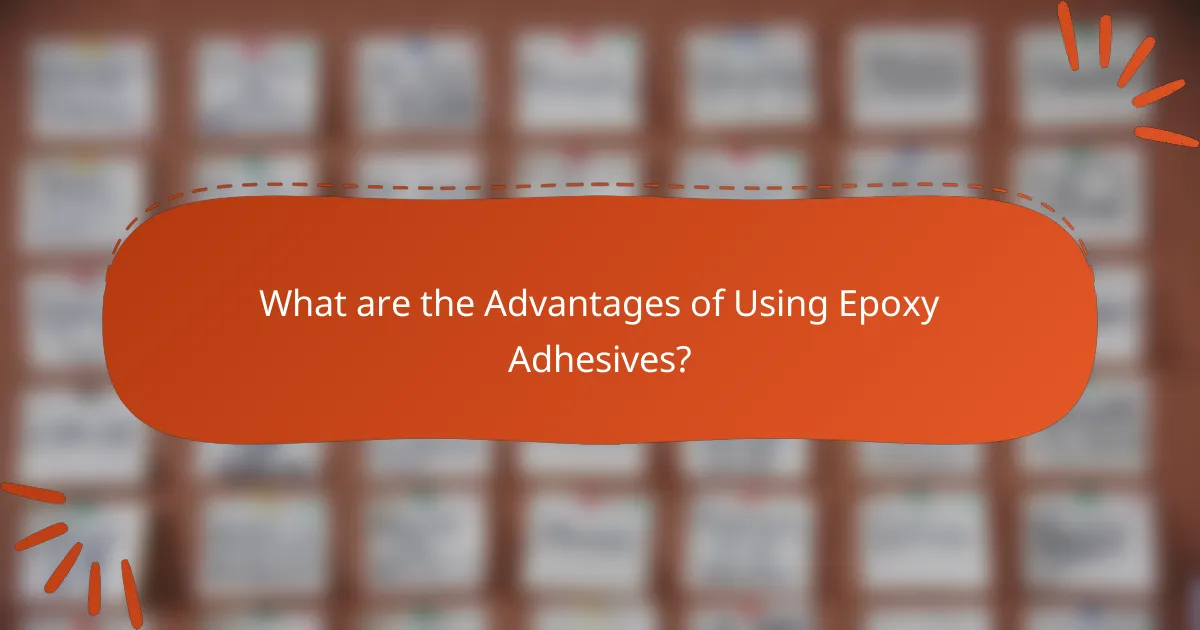
What are the Advantages of Using Epoxy Adhesives?
Epoxy adhesives offer strong bonding capabilities, making them ideal for various applications. They create durable bonds that can withstand extreme conditions. Their resistance to moisture and chemicals enhances their versatility. Epoxy adhesives also have excellent gap-filling properties, allowing them to bond uneven surfaces effectively. They exhibit high tensile strength, which contributes to the longevity of the bond. Additionally, epoxy adhesives can be formulated for specific needs, such as fast curing or high-temperature resistance. Their versatility and performance make them a preferred choice in construction and manufacturing industries.
Why choose Epoxy Adhesives over other adhesive types?
Epoxy adhesives are preferred over other adhesive types due to their superior bonding strength and versatility. They create strong bonds on a variety of surfaces, including metals, plastics, and wood. Epoxy adhesives are resistant to heat, chemicals, and moisture, making them suitable for demanding applications. Their curing process allows for a durable and long-lasting bond. In fact, epoxy adhesives can withstand temperatures up to 150°C. Additionally, they have excellent gap-filling properties, which enhance their usability in uneven surfaces. These attributes make epoxy adhesives ideal for construction, automotive, and aerospace industries.
What are the key benefits of using Epoxy Adhesives in construction?
Epoxy adhesives provide strong bonding capabilities in construction. They exhibit excellent adhesion to various materials, including metal, wood, and concrete. This versatility allows for diverse applications across different construction projects. Epoxy adhesives also offer high resistance to environmental factors such as moisture and temperature fluctuations. Their durability ensures long-lasting bonds, reducing the need for frequent repairs. Additionally, epoxy adhesives cure to form a rigid structure, enhancing the overall strength of the assembly. These properties make them ideal for demanding applications like structural repairs and load-bearing joints. The combination of strength, durability, and versatility makes epoxy adhesives a preferred choice in the construction industry.
How do Epoxy Adhesives contribute to durability and strength?
Epoxy adhesives contribute to durability and strength through their chemical composition and bonding capabilities. They form strong covalent bonds with substrates, which enhances structural integrity. Their resistance to environmental factors, such as moisture and temperature fluctuations, further increases longevity. Epoxy adhesives can withstand heavy loads and stress, making them suitable for demanding applications. The curing process results in a rigid and tough material, providing excellent impact resistance. Research indicates that epoxy adhesives can achieve tensile strengths exceeding 5000 psi. This performance makes them ideal for construction, automotive, and aerospace industries.
What are the specific advantages of different application methods?
Different application methods of epoxy adhesives offer unique advantages. Brush application allows for precise control and even distribution. This method is ideal for small or intricate surfaces. Roller application covers larger areas quickly and evenly. It is effective for flat surfaces and minimizes air bubbles. Spray application provides a fine mist, ensuring a smooth finish. This method is suitable for complex shapes and hard-to-reach areas. Injection application allows for deep [censured] into joints, enhancing bond strength. It is particularly beneficial for repair work. Each method caters to specific project needs, optimizing efficiency and effectiveness.
How does the method of application influence the performance of Epoxy Adhesives?
The method of application significantly influences the performance of epoxy adhesives. Application techniques affect the adhesive’s bond strength and curing characteristics. For instance, brushing or rolling can lead to uneven application, which may weaken the bond. Conversely, using a syringe or nozzle can ensure a consistent layer, enhancing adhesion.
Surface preparation is also critical. Properly cleaned surfaces improve the adhesive’s ability to bond effectively. Additionally, the thickness of the adhesive layer impacts curing time and strength. Thicker layers may trap air and moisture, leading to incomplete curing.
Research indicates that optimal application methods can increase bond strength by up to 50%. Therefore, selecting the correct application technique is essential for maximizing the performance of epoxy adhesives.
What are the cost implications of various application methods?
The cost implications of various application methods for epoxy adhesives vary significantly. Spray application typically incurs higher costs due to equipment and material waste. Brush application is more economical, but may require more labor time. Roller application offers a balance between speed and cost, making it a popular choice. Manual mixing and application can reduce expenses, but may affect consistency. Automated systems, while initially expensive, can lower long-term costs through efficiency. Each method’s overall cost also depends on the scale of the project and the specific adhesive used.
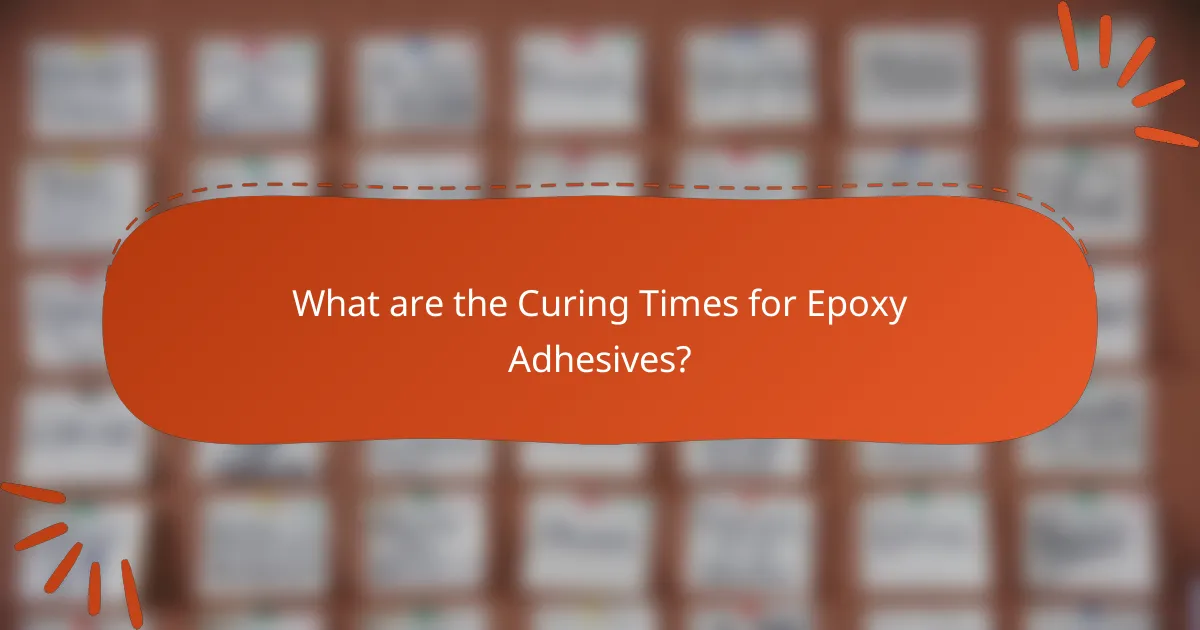
What are the Curing Times for Epoxy Adhesives?
Curing times for epoxy adhesives typically range from 5 minutes to 24 hours. The initial set time can be as short as 5 to 30 minutes. Full cure may take 24 hours or longer, depending on the formulation and environmental conditions. Factors such as temperature and humidity can significantly influence these times. For example, higher temperatures usually accelerate curing. Conversely, lower temperatures can prolong the process. Manufacturers often provide specific recommendations for their products. Following these guidelines ensures optimal performance and bond strength.
How does temperature affect the curing time of Epoxy Adhesives?
Temperature significantly affects the curing time of epoxy adhesives. Higher temperatures accelerate the curing process, while lower temperatures slow it down. For instance, at 70°F (21°C), epoxy may cure in 24 hours. However, at 90°F (32°C), this time could reduce to 6-8 hours. Conversely, at 50°F (10°C), curing might take 48 hours or longer. This variation occurs because heat increases the molecular activity within the epoxy, promoting faster chemical reactions. Studies have shown that a 10°F increase can halve the curing time. Therefore, temperature is crucial in determining how quickly epoxy adhesives set and achieve full strength.
What are the typical curing times for various Epoxy Adhesives?
Typical curing times for various epoxy adhesives range from 5 minutes to 24 hours. Fast-curing epoxy adhesives can set in as little as 5 to 15 minutes. Standard epoxy adhesives usually cure within 24 hours. Some specialty formulations may take longer, up to several days, to reach full strength. The specific curing time can depend on factors such as temperature and humidity. For example, higher temperatures can accelerate curing. Conversely, lower temperatures may extend the curing process. Always refer to manufacturer guidelines for precise curing times.
How can curing times be optimized for different applications?
Curing times for epoxy adhesives can be optimized by adjusting temperature and humidity conditions. Higher temperatures generally accelerate curing reactions, reducing overall curing time. Specific formulations may also be used to enhance curing speed without compromising bond strength. Additionally, utilizing accelerators or hardeners can significantly shorten curing times for various applications. For instance, some epoxy systems are designed to cure quickly at room temperature while others may require heat for optimal performance. The choice of substrate and the thickness of the adhesive layer can also influence curing efficiency. Studies have shown that controlling these variables can lead to improved productivity and performance in adhesive applications.
What factors influence the curing process of Epoxy Adhesives?
The curing process of epoxy adhesives is influenced by several key factors. Temperature plays a significant role; higher temperatures generally accelerate curing. Humidity levels can also affect the curing time; excessive moisture may lead to improper curing. The ratio of resin to hardener is crucial; an incorrect mix can result in incomplete curing. The type of hardener used impacts the curing speed; some hardeners are designed for rapid curing while others are slower. Surface preparation affects adhesion and curing; clean, rough surfaces promote better bonding. The presence of contaminants can hinder the curing process; oils or dust can interfere with adhesion. Lastly, the thickness of the adhesive layer influences curing time; thicker layers may cure more slowly due to reduced heat dissipation.
How do humidity and surface preparation affect curing times?
Humidity and surface preparation significantly affect curing times of epoxy adhesives. High humidity can slow down the curing process. This occurs because moisture in the air can interfere with the chemical reactions needed for curing. Conversely, low humidity can accelerate curing times by promoting faster evaporation of solvents.
Surface preparation is equally crucial. Properly prepared surfaces enhance adhesion and promote uniform curing. Contaminants like dust, oil, or moisture can hinder the curing process. Studies indicate that surfaces that are clean and dry can lead to optimal curing times, often within the manufacturer’s recommended range.
In summary, both humidity and surface preparation play critical roles in determining the efficiency and speed of epoxy adhesive curing.
What are common mistakes to avoid during the curing process?
Common mistakes to avoid during the curing process of epoxy adhesives include inadequate mixing of components. Insufficient mixing can lead to incomplete curing and reduced bond strength. Another mistake is applying the adhesive in extreme temperatures. Curing at temperatures outside the recommended range can impair the adhesive’s performance. Additionally, failing to follow the manufacturer’s recommended curing time is a frequent error. Rushing the process can result in weak bonds. Not allowing for proper ventilation during curing can also be problematic. Poor airflow can affect the curing reaction and lead to undesirable results. Lastly, ignoring surface preparation can hinder adhesion. Clean and properly prepared surfaces are crucial for optimal curing and bond integrity.
What are some best practices for applying Epoxy Adhesives effectively?
To apply epoxy adhesives effectively, ensure surfaces are clean and dry. Remove any dirt, grease, or old adhesive. Use a suitable mixing ratio as specified by the manufacturer. This ensures optimal bonding strength. Mix the epoxy thoroughly to achieve a uniform consistency. Apply the adhesive evenly using a suitable tool, such as a spatula or brush. Press the surfaces together firmly to eliminate air pockets. Allow the epoxy to cure undisturbed for the recommended time. Proper curing enhances the adhesive’s strength and durability. Following these practices will improve the effectiveness of epoxy adhesives.
Epoxy adhesives are strong bonding agents composed of epoxy resin and hardener, known for their excellent adhesion to various substrates such as metals, plastics, and wood. This article explores the application methods of epoxy adhesives, including brush, roller, and syringe techniques, highlighting their advantages and the impact of different formulations on performance. Additionally, it covers curing times, how temperature and humidity affect curing, and best practices for effective application. Understanding these aspects is crucial for optimizing the use of epoxy adhesives in industrial and DIY projects.
